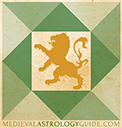Angularity
An important piece of the interpretation puzzle that is often overlooked in modern forms of astrology is angularity. The twelve houses are grouped into a few different categories, with angularity being the most well-known. Houses are either angular, succeedant, or cadent depending on their relationship with the angular degrees of the chart. The angular houses are those whose cusps are measured from those angular degrees; the First house (the Ascendant), the Tenth house (the midheaven), the Seventh house (the descendant), and the Fourth house (the IC). The succedent houses are placed before the angular houses (Eleventh, Eighth, Fifth, and Second). These houses follow the angles and will take their place in time. Finally, the cadent houses (Twelfth, Ninth, Sixth, and Third) come after the angles.
A planet's position by house has a profound effect on how that planet operates. While dignity deter- mines the quality of the planet and what ultimately the quality of what it can produce, angularity is more about quantity. Angular planets are able to produce a lot more of what they signify, succedent houses produce a middling amount, and cadent houses produce a small amount. Another way to think about angularity is through a sound or volume analogy. Planets in angles operate at 100% volume, succedent houses only produce about 50%-75%, and those in cadent houses may only operate between 25%-50%.
Angularity becomes easier to understand when we view the houses as astronomical entities that mark the progress of planets through the sky. Typically, we're taught to follow the houses in numerical order: First, Second, Third, Fourth, etc. and then to view them as sub-groups of angular/succedent/cadent that also follows the numerical pattern (First/Second/Third, Fourth/Fifth/Sixth), but planets don't actually move within the houses like this. Astronomically, planets move in a clockwise motion around the chart, beginning in the First house, moving to the Twelfth, and then the Eleventh. Angular groupings also make more sense when we start with the succedent houses and organize them from there (Eleventh/Tenth/Ninth or Second/First/Twelfth).
Below are three images which show the progression of planets through the houses on the same day taken at 2 hour intervals.
The first chart captured at 06:26 AM features the Sun rising in the angular first house conjunct the Ascendant. Saturn is placed near to the cusp of the succedent eighth house. Two hours later at 08:26 AM the Sun has fallen off of the angle and into the cadent twelfth house while Saturn has progressed to the Descendant, making himself angular within the Seventh house. In the final chart set for 10:26 AM, the Sun has moved into the succedent Eleventh house and will shortly make his way into the angular tenth house. In the meantime, Saturn has fallen from his position off of the Descendant and into the cadent sixth house. The motion of these planets from a succedent house to an angular house before moving into a cadent house will repeat as the day goes on.
Taking a moment to appreciate the astronomy behind the houses makes it easier to see why the concept of angularity in relation to house position is so important. When viewed from earth, the sky is an ever-revolving sphere and the angles (Asc, MC, Dsc, and IC) are significant points where planets appear to shift direction.
In any given chart, each planet will be at a different place in its diurnal cycle. Some will be more cadent, others more angular, but there will always be one that is the most angular or nearest to its corresponding angular degree. This planet is really significant as it is the planet with the most power to bring about what it signifies. In nativities, this planet often shows areas of life with heightened activity or significance.
In this chart, Mercury is the most angular planet, being only one degree away from the degree of the Midheaven. The Sun is the second most angular planet also being placed in an angular house, but further from the angular degree than Mercury. Saturn is the next most angular planet after the Sun as he is conjoined the cusp of the succedent eighth house. Venus, Mars, and Jupiter are most angular following Saturn in that order until we reach the Moon who is the most cadent planet, having recently fallen from the degree of the Descendant.
With Mercury as the most angular planet, an astrologer could reasonably assume that First, Second, and Fifth house topics are going to be the most active or noticeable about this individual's life since Mercury rules them, while Third house topics are going to be the least active or noticeable because they are signified by the Moon who is the "quietest" planet in the chart due to her extreme cadency.
Angularity is a really effective method of chart analysis and is really simple. It's easy to look at a chart and immediately identify more active planets and the areas of life they signify. What's your most angular planet and how do those areas of life manifest?





